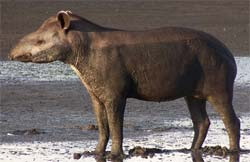Father Falkner's book on Patagonia (1774).
Perhaps the key to the mystery of “lake bulls”, calimayo and Patagonian hippopotamus was revealed over two centuries ago by Jesuit father Thomas Falkner.
Falkner wrote a very interesting book Description Of Patagonia in 1774 reporting his first hand experience with Tehuelche natives in the Pampas just north of Patagonia. He described the geography, rivers, animals, fish and natives of Patagonia and, regarding the wildlife, he wrote that:
there are also many anta […] of the stag kind, but without horns. Its body is as big as that of a large ass; its head very long and tapering, ending in a small snout; its body very strong, and broad at the shoulders and haunches; its legs and flanks are long, and stronger than those of a stag; its feet cloven like those of a stag, but something larger; its tail short, like that of a deer.[1]
“Anta” was the Spanish and Portuguese word for Tapir. These animals are a relict species that managed to survive the megafauna of the Late Pleistocene era. They belong to the mammalian order of Perissodactyla together with horses, asses, zebras and rhinoceroses. Tapirs are large creatures about the size of a donkey that have a barrel shaped body with a tapering front and rounded rear; designed for moving about the forests quickly. They have long flexible snouts, short stubby tails and four toes on their front feet and three on their rear ones.
Of the four known species of tapir, one lives in Asia, and the other three thrive in the warm South American jungles. Falkner may have seen them in Paraguay, which he visited or in the Pampas and Patagonia.
Lowland Tapir, wild, Brazil. Photo by Richard Bodmer. From [2]
Patagonia is too dry and cold for tapirs
There is only one problem with the tapir hypothesis: there are no known tapirs in Patagonia and the current southernmost range of their habitat is about 1,200 km (750 mi.) to the north of Patagonia in Argentina’s tropical and subtropical jungles (click on this external map to see the global distribution of tapirs).
The drier open “monte” region that stretches between these lush jungles and Patagonia would have been an insurmountable obstacle in their migration to the verdant Andean forests. Tapir are fond of water and this transitional region lacks water; moreover its arid environment could not even provide enough vegetation to feed them.
But Falkner insisted
Yet Falkner explicitly noted that the Tehuelche sold tapir hides to the Mapuche so that these could make body armor from them.
For those who think that he was mistaken, in the same passage that he mentions the anta, he also mentions the guanaco, so he was not misguided about the animal; Falkner was adamant about the existence of tapirs in Patagonia.
Patagonia’s arid steppe, lacking vegetation and water could not be home for tapirs, and Falkner correctly places them to the west of the steppe, in humid grasslands at the foot of the Andes.[1] The damp mountain forests could have offered them a safe habitat.
Tapir must be the Patagonian "lake bull"
The tapir with its large size, bulky shape and fondness for water could easily be the lake monster that we have been seeking. See the following photograph of a swimming tapir. It definitively looks "horse-like" (a Calimayo perhaps?).
Adult Lowland tapir swimming. Parque Nacional Brasilia, Brazil.
Copyright © 2006 Paulo Andre Lima Borqes. From [2].
Copyright © 2006 Paulo Andre Lima Borqes. From [2].
To be Continued...
But, can we confirm its existence in Patagonia? We will continue in our next post.
See the final (Part 3) post here.
Also, my Feb. 2010 post on Patagonian tapirs - more evidence.
Bibliography.
[1] Falkner, T. Op Cit. pp. 106+
[2] Tapir Specialist Group Tapirs of the World
Copyright 2009-2010 by Austin Whittall ©
Patagonian Monsters Cryptozoology, Myths & legends in Patagonia



















No comments:
Post a Comment